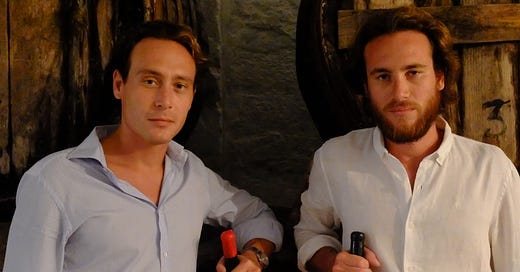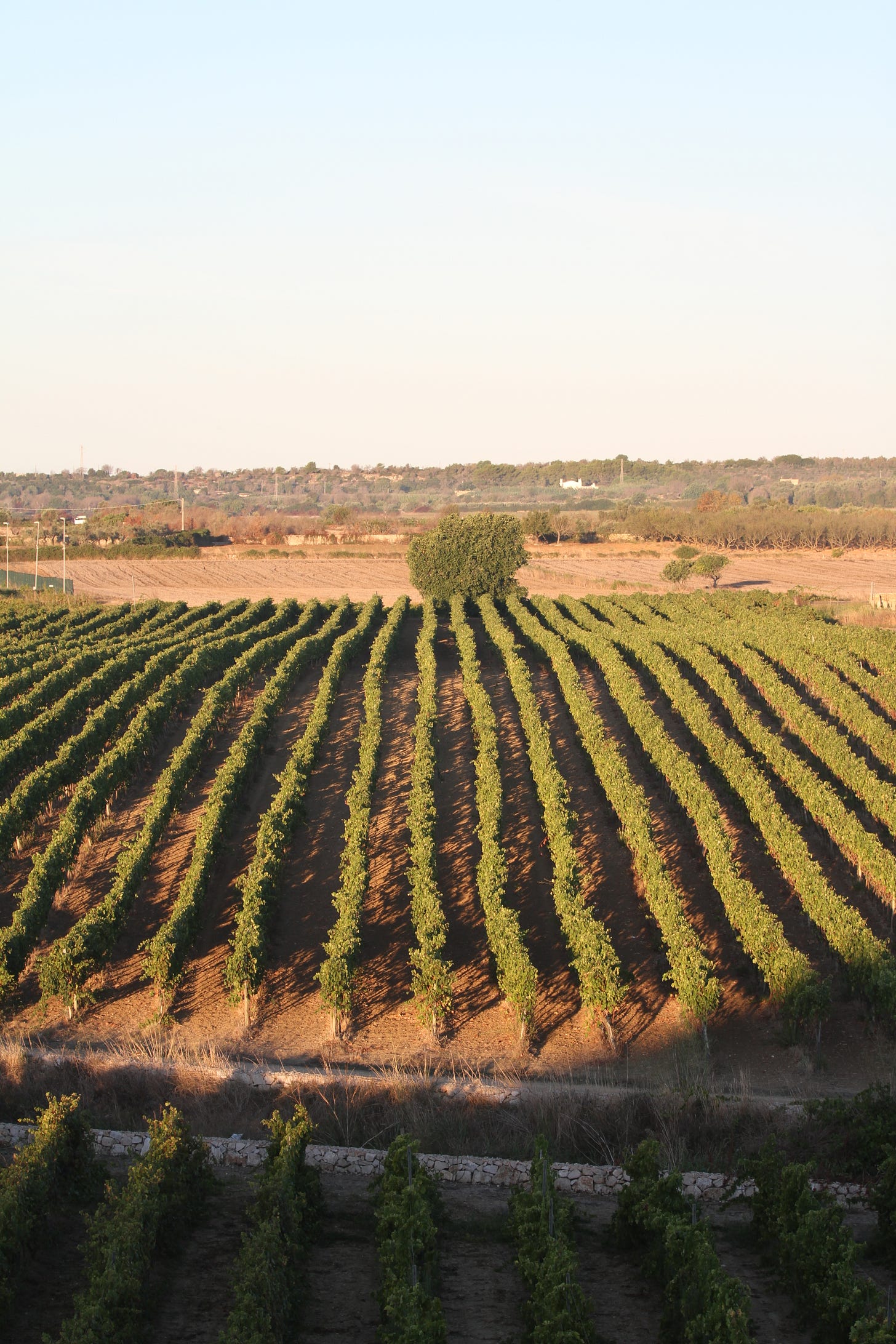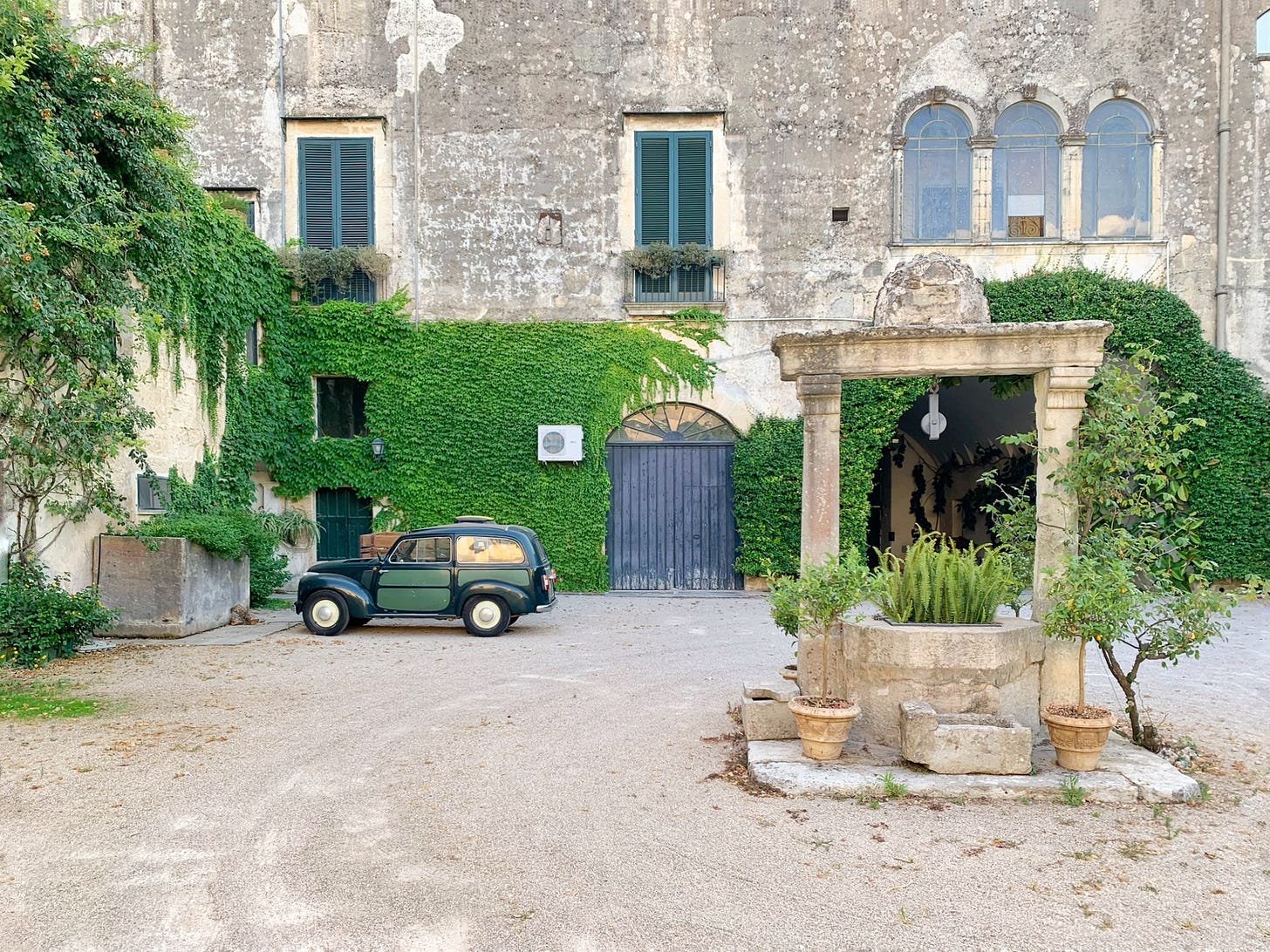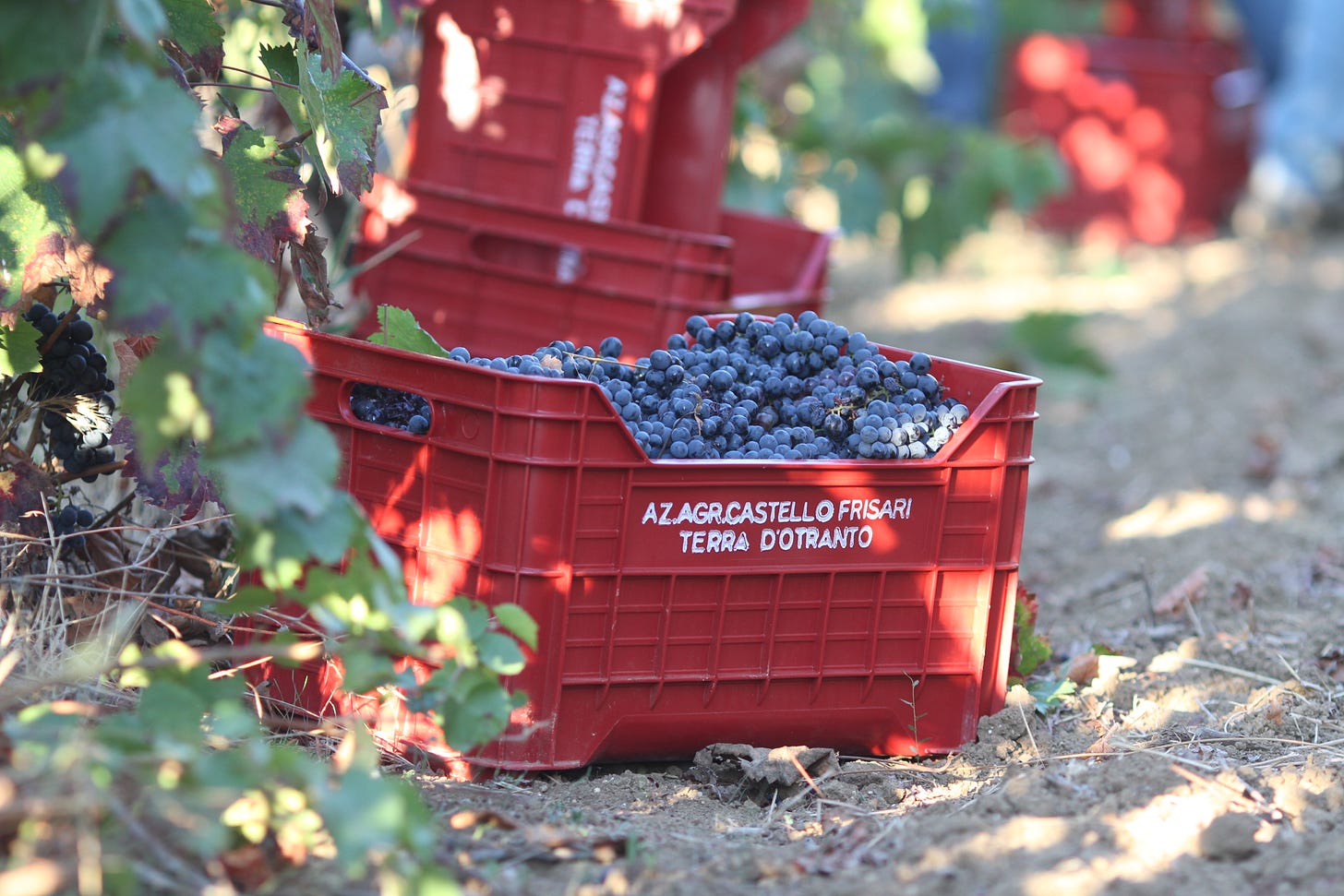Meet Carlo Guarini, Co-Founder of Castello Frisari, a New Winery Elevating Puglia's Wine Scene
Issue #95
When you think of Italian wine regions, you likely think of Tuscany, Piedmont, and maybe Veneto, Sicily, or Sardinia. But what about Puglia? According to Statistica, Puglia is the region producing the second largest volume of wine in Italy. Much of it is table wine, or perhaps gets blended with other wines, but a few dynamic young vintners are working to change Puglia’s wine industry. One such producer is Carlo Guarini, who along with his brother Roberto, founded a new winery called Castello Frisari.
I met Carlo and Roberto in 2019 on my first trip to Puglia and was fascinated by their story. At the time, I was there to visit their father’s winery, Duca Carlo Guarini, in the little village of Scorrano deep in the heart of Salento. They were in the early stages of building their winery in their family’s 800-year-old castle, but the construction got delayed because of Covid.
I reconnected with them last summer, as they were finally getting back on track to launch the winery, and re-pitched the story to my editor at Hemispheres. This interview with Carlo was conducted in conjunction with my article, which is out now in the July issue. I’m thrilled to share it as part of my series of interviews with entrepreneurs and creatives doing cool things in Italy.
I thought we could start with a bit of history to refresh my memory. Your family has been producing wine for 900 years, right?
Exactly. My brother and I come from the Guarini family, which has been producing wine for 900 years. The first document attesting to the family’s vineyards dates back to 1400.
And your family is noble, right?
Yes, the first member was Accardo Guarini, who was the Count of Valesio. Valesio is an ancient city that doesn’t exist anymore. It’s just an archeological site between Brindisi and Torchiarolo. In fact, the Guarini family vineyards are still there in that area.
Your family has really deep roots in the area.
We have deep roots in Salento, yes. We’ve been in Salento since 1065.
Incredible. The building, though, where you’re creating Castello Frisari is a bit newer, relatively speaking, no?
Actually, the castle was born in the Norman period, so in 1100. You have to consider that Scorrano, the town where we’re located, dates back to the Roman Empire. It was a strategic position because it’s halfway between Gallipoli and Otranto. In the historic center, you can see the Medieval structure, with the old walls. Only one of the old city gates has survived—the western one that goes toward Gallipoli. And so in the city was the feudal castle for the protection of the town. So it was born as a fortress with the objective of controlling and protecting the administration of the feudality.
Originally, the structure had walls, a moat, and towers. Later, from the 17th to 18th centuries, it underwent some changes because from 1600 on, there was less of a need for protection. In fact, many towns including Scorrano saw the crumbling of the walls because there wasn’t a need for them, and so the feudality had the possibility to make the castle more comfortable. From the 1600s, it was transformed into a more habitable palace instead of a fortress, so this was the motivation for the architectural changes—and it’s a beautiful thing that we can see the stratification of the castle during different periods, up until the 1800s.
So it has lived all this history and it passed through the hands of many feudal families, from the first feudatory of Scorrano, who was Galardo de Saumeriaco. And then there were various families, including Marie d’Enghien, the Borboni, the De Capo, the Gonzaga, then in 1687 it became the property of the Frisari family. The Frisari family took the feudality of Scorrano, was elevated in 1718 to the duchy, and from there, the Frisari family inserted itself.
And the Frisari family is on your mother’s side?
My father’s side, on the side of the Guarini. What happened is the Frisari family arrived in the 1680s, in 1718 it became a duchy, and the castle was theirs until 1894, when the last Frisari—Teresa—married Carlo Guarini, and so the feudality was passed to the Guarini family because there were no more Frisari heirs. The Frisari family doesn’t exist anymore.
I remember you were telling me there was a feminine story there.
They were all women. And one of these sisters—Teresa—married into the Guarini family and so everything was passed onto the Guarini family, which until the end of the 1800s still lived in Poggiardo.
So you decided to call your winery Castello Frisari as an homage to them?
Exactly. This castle has been continuously inhabited since the beginning. It was never abandoned and then retaken. That’s why you see the stratification, the continuity of lives lived inside it. It pushed us to restore a part that since the 1940s wasn’t used anymore and turn it back into a winery.
I don’t know if you remember the courtyard and then the partially underground part—that was the old winery where wine was produced and sold on tap until the 1940s. Outside the castle until the early 1900s, there was the vineyard. In fact, we have a book that tells the story of how the Frisari family acquired the feudality and shows what the castle looked like back then too. There’s this page with the acquisition of the vineyard. It was called Vigna della Corte and was acquired by the Frisari family in 1711. So with my brother, we wanted to give some continuity to the use of this place, so we called it with the name Frisari.
Part of the castle is still inhabited, right? And part of it is your mother’s ceramic studio?
The castle is still our family’s home and now my father is the fourth generation owner, who lives there. And my mother, who makes ceramics, has her studio there and she makes these ceramics with a style more inspired by graphic design, sort of a mix of traditional objects and a more modern design. Being a graphic designer, she brought this style to her ceramics.
How did you decide to create your winery there?
My brother Roberto and I decided to take on this new project of creating a winery because we wanted to concentrate on a concept of wine tied to the terroir, focused on Negroamaro, the primary variety of the cape of Salento, the land of Otranto, and the diverse viticultural zones of this area. So to connect the concept of vinification not only to what happens in the winery, but foremost to the characteristics of each vineyard.
So to understand the viticultural potential of the terra d’Otranto, we chose vineyards and areas that were abandoned over the last 70 years because the prevailing logic of the mid-20th century was to produce bulk wine, so the majority of the production was done in areas where they could produce more extensively. So all the areas of the cape were more fragmented with terrains that changed, also a bit far from the railroads and transport. These areas were slowly abandoned, but they’re perfect for making wines with character because they’re completely different from the areas where the majority of the wines of Salento were produced.
Because in the past, Puglia was known more for quantity than quality when it comes to wine, right?
Exactly. All these terrains in the south of Salento were abandoned for this reason. They were less productive. The production of Puglia was meant for quantity and in the Cape, it was hard to produce large quantities. Higher up, where now the majority of the wineries in Salento are located, the vineyards are more spread out, more comfortable, also more fertile in a sense, so more adapted to that type of production, whereas my brother and I were looking for the opposite: interesting terrains with exposure to wind, proximity to the sea, each one different from the others—precisely to connect each bottle with the terroir. So it’s a different viticultural project.
Why did you decide to launch a new winery instead of doing this project through your father’s winery? What did he say?
He was actually one of our first supporters. Our idea was very, not different, but more specific. We needed new terrains. My brother had different vinification techniques in mind. We wanted to communicate Negroamaro in a more direct way and it’s one thing to add a line of wines to a winery that already has its image, its history, and its network; it’s another to go directly to the point that interests you. My brother and I wanted to go in that direction. Our gamble is to elevate Negroamaro and the Terra d’Otranto to higher levels.
Puglia has grown enormously in terms of wine. We want to do more. We want to create a permanent connection between the land and the product. We’re not interested in quantity, but in quality and the particularity of the wines. In fact, the bottles of red wine are all numbered and labeled with the specific vineyards they come from. We want to connect this concept as much as possible, so we have to do something that has nothing to do with our family’s winery. We want to create our own thing.
Are you producing exclusively Negroamaro?
Yes, we only produce Negroamaro DOC of Terra d’Otranto in red, rosé, sparkling...
I remember you were explaining that Negroamaro is very versatile. You can make sparkling, white, rosé, red... but for someone who doesn’t know Negroamaro, what are the characteristics of this wine?
It’s a flavorful grape with a good freshness because it has nice acidity. The flavors are very Mediterranean, from Mediterranean herbs—from pepper, tobacco, and darker spices—and also this freshness that comes from its acidity. Then it depends on the vinification. In any case, it’s a grape that grows in the south, so along with these flavors and freshness there’s a fruitiness you find especially with young Negroamaro, like in a rosé or a young red. Or even a white is fruity when it’s young and becomes more flavorful as it ages.
So you have everything—a grape that gives you the chance to make sparkling, white, rosé, and red, so we’re betting on Negroamaro not only because it’s the most representative grape of the Terra d’Otranto, but also because of its extreme versatility. Then you can also play with the different terrains. We have vineyards in the southern part, on the western coast, in the center, now we also have one on the east coast. And we’ll see what we’re able to harvest. In this way, you can play with the exposure to wind, the quality of the land, which influences how round the wine is, how fresh it is, the flavors. The different areas give a different taste to the wine. Negroamaro gives you this amazing thing.
What’s the land like? Is it sandy? Rocky?
It depends on the parcel. We have limestone soil in some parcels, more sandy and reddish soil in others. This one on the east coast that we hope to start harvesting this year is tuff. And every terrain gives more minerality, more freshness, more roundness to the wines.
By playing with the terroir, and bottling the wine from each vineyard separately, you can show how the land and that specific climate can give you a fresher or more fruity Negroamaro or a mineral white wine from a vineyard near the sea. So you can take advantage of the potential that nature gives you instead of working in the winery. If you know the land, you’ve almost played your hand. You don’t need to be a chemist adjusting the wine. If you know the land and the vineyard, you can make a wine that’s as natural as possible, in the sense that it respects the terroir.
But are they natural or organic wines?
They are organic. We immediately started with organic wines when we took over the vineyards. Natural is a strange word in my view. Natural is a curious concept. We use indigenous yeast for Negroamaro from our area, so I don’t buy industrial yeast.
Is it a spontaneous fermentation?
No, it’s not a spontaneous fermentation. I select my yeast.
You’ll have to forgive me—I’m not an expert.
No, no, no, this is important. For the concept of spontaneous fermentation, the yeast you find on the grapes can be good or bad. Bad yeast obviously gives you a bad result in your wine. It can stink, or something can be off. So every year, we select the yeast for our grapes with the University of Lecce. We choose the good yeast, discard the bad bacteria, and use the good yeast to start the fermentation process for our wines. So we use what we might call a controlled naturalness. Also because after 12 months of effort, I don’t want my wine to stink. It’s not conceivable—because in our view, the wine has to be good above all. It has to be well made. It has to be a pleasurable, drinkable product.
In fact, when people come to do tastings, sometimes they say, “but I’m not an expert,” and I ask, “Are you enjoying the wine?” Yes, perfect. That’s fundamental because then we pass to a concept that’s too abstract. Wine has to be something that you enjoy drinking. And we try to respect the terroir and the variety in the best way possible, so if I have the possibility to use my yeasts, respecting the nature of the year and the vineyard, but cleaning them from the bad yeasts, it seems like a genius solution.
And then the vinification is done in stainless steel?
The vinification is all done in stainless steel. Even the reds are made in stainless steel because aging in wood is risky. Negroamaro in our opinion isn’t a grape that needs wood because it’s already structured, with good aromas, a good body, a good nose—it doesn’t need any construction through wood. And given that our objective is to respect the differences between the various crus, wood makes everything flat.
We want to understand what makes a Negroamaro from the sierra different from a Negroamaro from the plains. So we vinify them in the same way—both red—in this case to show the difference. My brother only uses wood for the fermentation with reds. He ferments a portion of the red wines in oak barrels, but for a technical question of micro oxygenation and to fix the color of the tannins through the wood. So they’re in wood for maybe three weeks. The aging is all done in steel and then in the bottle.
Did you and your brother study oenology?
My brother studied agriculture and oenology in Milan. Then he worked in a few places and did a few harvests around the world, in Napa Valley, New Zealand, Australia, France, Spain, and Tuscany. So he worked a bit and had some experiences, then he came back. So he takes care of the vineyards and the winery. I, on the other hand, have a background in economics, management, and marketing, so I take care of the rest.
Sounds like you’re a good team.
It’s a good mix.
When did you start to buy these abandoned vineyards?
In 2016.
And now how many hectares do you have?
Now we have five hectares.
And they’re a bit spread out, as you were saying?
They’re spread out in four parcels, of which three are productive and the last one we’ll see if it produces this year.
And when did you bottle your wine for the first time?
We bottled the first red wines from the 2016 harvest in November 2018.
Where can one buy your wines? Are they exported?
We have Italy and we have begun to export. In Europe, they’re in Belgium, Holland, England, Switzerland, the Czech Republic.
United States?
We’re almost there. Now I’m negotiating with a small importer in Chicago. So not yet, but I just did the FDA registration, so I hope to arrive in the States this year.
How many bottles do you produce per year?
At this moment, we have around 10,000 bottles. We’ll get to 15,000 or 18,000. The winery is a niche winery because the work is very selective. Consider that for an organic Negromaro, the average that you can harvest for a red is 900 kilos per hectare. We do 500 kilos per hectare—practically half.
We started to test our wines in 2018 and 2019, then 2020 was a disaster because of Covid, 2021 eh, let’s say from 2022, we started to slowly restart. Let’s say it wasn’t an easy start. Now that we’ve finally finished the winery, it’s different. Until now, we produced very little. Now with the winery finally operational, it’ll be nice to welcome people.
So you’ll start with tastings?
Yes, there will be tastings and visits of the winery, from the partially-underground winery with all the old barrels from the early 1900s and the old vats that were used until the 1940s to sell the wine. There we’ll display all the old barrels, vats, and equipment in order to retell the story of the wine that was produced inside the castle.
And then we can do tastings of our wines. We’re very interested in doing vertical tastings in order to compare the different years within each cru. So there will be tastings dedicated to comparing the crus and comparing the different years from a single cru. We’re very happy. It’s been hard, but we’re doing it.
Are there other wineries in Puglia doing interesting things similar to you?
In our area, we’re the only ones. In provincia di Lecce, no one comes to mind. Also because the choice to vinify as a DOC Terra d’Otranto, I think there are maybe 2, 3, or 4 wineries. We’re trying to launch this DOC, to involve more people. The next step after finishing the winery will be to involve other wineries and create a more cohesive and united winemaking region.
It would help the region and also you guys, no?
Of course. It takes time. It’s also a question of generations. It’s part of the project that I’ve already started to write and my brother also has started to write from an agronomic point of view. That’s the next step to create a subzone that’s recognized and cohesive, not just for who makes wine, but for anyone who lives in the region.
The goal is to connect the wines to the terroir and transmit value to the land. If that piece of land has value, then everything else has value. It shouldn’t be a commercial value, it should give real value to the area. The marketing efforts have little effect if they’re not connected to something tangible. There are Pugliese wines that are very famous and produce millions of bottles, but they’re not adding value to the region and you see that in the price of the land. It’s worth nothing. That means you’ve done nothing, you’ve given no value to the product you’ve created.
If someone wants to plan a wine-focused trip to Salento, what other wineries should they visit?
The ones I suggest to visit in this area are Castel di Salve in Depresa. It’s a good family winery with a nice story. Now the son Riccardo works in the winery and is very dedicated. That’s a good one to visit. Then Supersanum is interesting, it’s very small. I think they're two or three brothers. I don’t know what kind of visits they organize. Castel di Salve is definitely prepared to welcome people to the winery. And then in the area...
Your father’s winery?
Of course, absolutely! Another thing I want to tell you is that the entire architectural intervention has been done by our other brother. We’re three brothers.
What’s his name?
Federico Guarini and he has this studio called Sciveras Guarini. He lives in Milan. He really did an incredible job.
It’s a real family project.
Yes, we did everything with the three of us and then with the advice of my father and my mother.
Further Reading
You can see the full July issue of Hemispheres here. (Flip to page 24 to read my article about Castello Frisari.)
Carlo and Robert’s father’s winery, Duca Carlo Guarini, is included in this article I wrote for Architectural Digest after my 2019 trip about how to plan the perfect road trip in Southern Italy.
Curious to learn more about the region? Check out my piece about why you should plan a trip to Puglia.
You can see all of the interviews in this series here.












Loved the article and the story of this family. Looking forward to visit it!
We were lucky to have stayed in their gorgeous vacation rental. Their mother was completely charming as was her son.